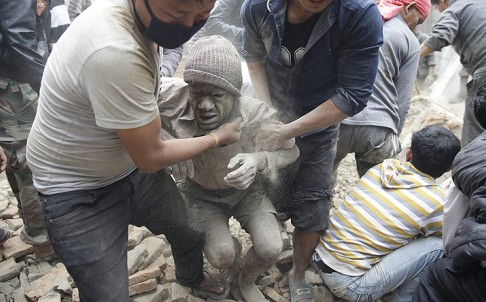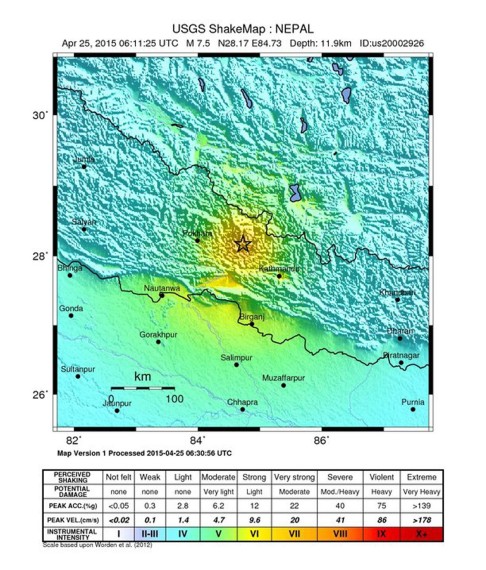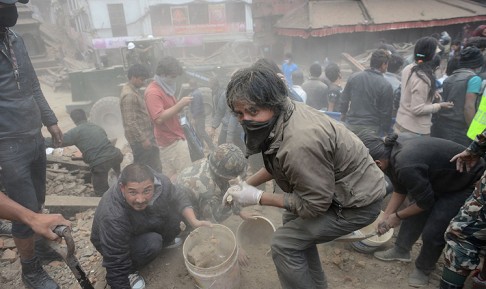Buildings collapse, hundreds killed as 7.9 magnitude quake strikes Nepal
Death toll expected to rise as rescuers continue to sift through rubble in search of survivors and reports of fatalities during avalanches around Mouth Everest come in
PUBLISHED : Saturday, 25 April, 2015, 3:04pm
UPDATED : Saturday, 25 April, 2015, 10:03pm
Agence France-Presse in Kathmandu

Rescuers pull a man from the rubble of a destroyed building after the earthquake hit. Photo: EPA
A massive 7.9 magnitude earthquake killed hundreds of people on Saturday as it ripped through large parts of Nepal, toppling office blocks and towers in Kathmandu and triggering an avalanche that hit Everest base camp.
Deputy Inspector General of Police Komal Singh Bam said late on Saturday at least 876 people were known to have died in Nepal but that the eventual toll could be much higher, while more than two dozen people were also reported killed in neighbouring India, China and Bangladesh.

Dust rises over the city during the quake. Photo: EPA
“Deaths have been reported from all regions except the far west. All our security personnel have been deployed to rescue and assist those in need,” Bam said.

Injured people in Kathmandu get medical attention after the earthquake hit Nepal. Photo: AP
Officials said an avalanche had buried parts of Mount Everest’s base camp in Nepal where hundreds of mountaineers have gathered at the start of the annual climbing season.
“An avalanche from Mount Pumori has hit the base camp, burying a part of it,” Gyanendra Kumar Shrestha, an official in Nepal’s tourism department, said.
“We are trying to assess how many are injured. There might be over 1,000 people there right now, including foreign climbers and Nepalese supporting staff.”

This map from the US Geological Survey shows the area of the quake. Photo: EPA
Journalist Ammu Kannampilly, on an assignment to Everest, was among those caught up in the chaos and reported that snowfall meant it was impossible for helicopters to reach the area.
Two experienced mountaineers said that panic erupted at base camp which was full of climbing teams and had been “severely damaged”, while one said the quake triggered a “huge avalanche”.
But the worst damage was reported in Kathmandu, where the historic nine-storey Dharahara tower, a major tourist attraction, was among the buildings to have been brought down.

Volunteers help with rescue work at the site of a building that collapsed after the earthquake. Photo: AP
At least a dozen bodies were taken away from the ruins of the 19th-century tower, according to a photographer who saw similar scenes of multiple casualties in other parts of the city.
While contact with Nepal was sporadic, a senior Nepalese diplomat warned that the final toll could run into many hundreds.

Volunteers clear rubble in Kathmandu's Durbar Square, a Unesco World Heritage Site that was severely damaged. Photo: AFP
“We have received reports that there is a big loss of property and life in Nepal,” said Krishna Prasad Dhakal, the deputy chief of mission at Nepal’s Embassy in New Delhi.
“Possibly hundreds of people have died in various parts of the country, particularly in Kathmandu and Pokhara.”
At least 26 people were known to have died in India, including 17 in the eastern state of Bihar, while buildings in the capital New Delhi had to be evacuated.

a family takes refuge in the street outside a school in Kathmandu after a the earthquake struck. Photo: Reuters
The United States Geological Survey and India’s meteorological service said the shallow quake struck 77km northwest of Kathmandu with walls crumbling and families racing outside their homes.
“The walls of houses have collapsed around me onto the road. All the families are outside in their yards huddled together,” an witness said in Kathmandu.
Another resident recounted scenes of panic and mayhem.

Nepalis inspect a damaged road in Kathmandu. Photo: Xinhua
“Everything started shaking. Everything fell down. The walls around the main road have collapsed. The national stadium’s gates have collapsed,” Anupa Shrestha said.
The quake tore through the middle of highways in the capital and also caused damage to the country’s only international airport, which was briefly closed.
Kari Cuelenaere, an official at the Dutch embassy, said the impact had swept the water out of a swimming pool at a Kathmandu hotel where Dutch national day was being celebrated.

“It was horrible, all of a sudden all the water came up out of the pool and drenched everyone, the children started screaming,” Cuelenaere said. “Some parts of the city fell down, there was dust rising ... There were many [rescue] helicopters.”
Aftershock tremors could be felt more than two hours after the initial quake.
Initially measured at 7.5 magnitude, the quake was later adjusted to 7.9, with a depth of 15km the USGS said. It hit 73km east of the tourist town of Pokhara.
Witnesses and media reports said the tremors lasted between 30 seconds and two minutes.
“We are in the process of finding more information and are working to reach out to those affected, both at home and in Nepal,” Indian Prime Minister Narendra Modi said in a tweet.
China’s official Xinhua news agency said that two people, including an 83-year-old woman, were killed in the Tibet region as a result of the quake.
The earthquake was also felt across large areas of Bangladesh, triggering panic in the capital Dhaka as people rushed out onto the streets.

A soldier searches for trapped people at a collapsed house in Shigatse, China's Tibet Autonomous Region. Photo: Xinhua
In the garment manufacturing hub of Savar, on the outskirts of Dhaka, at least 50 workers were injured after the quake set off a stampede in a garment factory, according to the private Jamuna television.
The area has a history of earthquakes, with a 6.8 magnitude quake that hit eastern Nepal in August 1988 killing 721 people.
A magnitude 8.1 quake killed 10,700 people in Nepal and eastern India in 1934.
